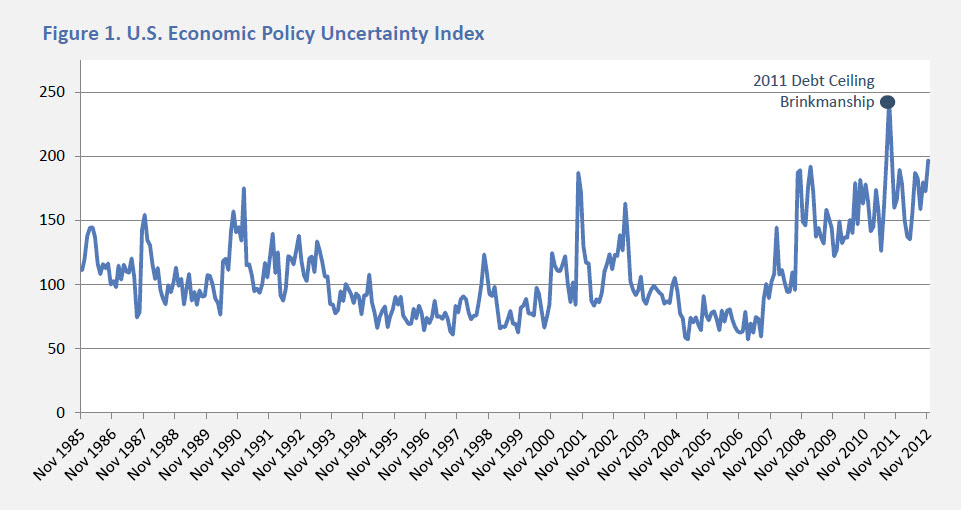Investing and uncertainty
There are many things in short supply, but uncertainty is not one of them. Three economists1 have compiled an index of uncertainty, which is comprised of newspaper coverage of policy-related uncertainty, expiring federal tax code provisions and disagreement among economic forecasters. You can see the trend in Figure 1 below. The index peaked with the debt ceiling imbroglio in late 2011, fell in the early part of 2012 and then rose again.
Throughout the year there has been a great deal of focus on a number of worrisome issues, including the U.S. deficit, debt ceiling and the fiscal cliff, high unemployment, and the European debt situation. Reflecting all this angst, investors through November withdrew a net $88.9 billion from actively-managed U.S. stock mutual funds (net of inflows into U.S. stock exchange-traded funds).2 Yet for 2012, stocks were up nicely.
How could stocks have gone up while uncertainty increased? While many people naturally worry about the past and still feel burned by previous sharp plunges in stock prices, the stock market is forward looking, incorporating the perceptions of millions of investors. While national economies are still relatively sluggish, actions taken by the U.S. and European central banks to combat economic weakness are having a positive impact.
Housing, while not rosy, is seeing some welcome improvements, with 6.9% of U.S. consumers planning to buy a house in the next six months, the most since August 1999.3 Confidence among U.S. homebuilders reached a 6 ? year high in December.4 U.S. sales of previously occupied homes increased to their highest level in three years in November.5 And home prices rose 4.3% in the twelve months ending October 2012 in the S&P/Case-Shiller 20-City Composite.6
Another positive, with major longer-term implications, is the widespread development of hydraulic fracturing (or fracking, the process of extracting oil and natural gas from shale rock). The International Energy Agency projects the U.S. will become the largest global oil producer by around 2020, and a net oil exporter by around 2030.7 While there are important environmental issues associated with fracking, including potential contamination of local water supplies and massive use of water in the process, electricity produced by natural gas gives off 43% less carbon dioxide versus coal. Due to a combination of increased use of natural gas, the weak economy and more fuel-efficient cars, America?s emission of greenhouse gases has fallen to 1992 levels and is expected to continue to fall.8 So, like any energy source, there are costs and benefits. Cheaper energy will lead to more manufacturing being done in the U.S., which is good for the economy. One analyst estimates the U.S. will add three million new jobs by the end of this decade due to the natural gas industry.9
Waiting for that perfect time to invest when there is no uncertainty could lead to cash unproductively sitting on the sidelines. Investing only after good news also means buying stocks after they have gone up. A good example of this is the S&P 500 going up by 2.54% on January 2, the day after the fiscal cliff legislation passed. Another example is the MSCI EAFE index of developed countries in Europe, Australasia and the Far East, which increased 6.57% in the fourth quarter, reflecting the relative lack of bad news, and some stabilizing events, in Europe.
While uncertainty is an uncomfortable fact of life, it is easier to handle by following a well-formulated diversified investment plan that invests in stocks and bonds, the allocation to which incorporates your risk tolerance and long-term needs.
1. Scott Baker, Nicholas Bloom and Steven J. Davis at www.PolicyUncertainty.com. 2. Wall Street Journal, ?Investors Sour on Pro Stock Pickers?, 1/4/13.3. Ned Davis Research, 12/10/12.
4. http://finance.yahoo.com/news/us-homebuilder-confidence-6-1-150113216.html
5. Wall Street Journal, 12/20/12.
6. http://www.standardandpoors.com/indices/sp-case-shiller-home-price-indices/en/us/?indexId=spusa-cashpidff?p-us?- 7.Wall Street Journal, 11/12/12.
8. U.S. Energy Information Agency, as discussed in http://finance.yahoo.com/blogs/daily-ticker/fracking-good-economy-environment-155325507.html
9. As reported in New York Times, ?Welcome to Saudi Albany?, Adam Davidson 12/11/12.
Source: http://www.merriman.com/psychology-of-investing/investing-and-uncertainty/
naomi watts andrej pejic steve jobs fbi safehouse brown recluse brown recluse front door
No comments:
Post a Comment